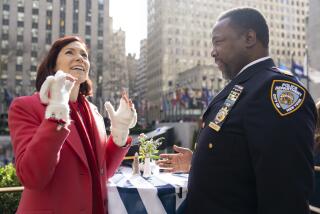TV’s First Responders ditch their DVR time-shifting so they can live-tweet in real time
From the moment it premiered, Showtime’s high-stakes, wildly ambitious spy thriller “Homeland” was not so much discussed as it was anointed. It was the first drama to both embody post-9/11 anxiety and serve as a master class in acting, a narrative high-wire act told from two distinct viewpoints in which the cost of war was endlessly calculated.
Two years later, “Homeland” has become a social media pinata, the subject of often outraged recaps, blogs and essays that gleefully harp on perceived flaws and inconsistencies. Last year the love affair between the two leads, Carrie (Claire Danes) and Brody (Damian Lewis), kept recappers and critics in perpetual churn while previous praise for Brody’s daughter Dana did such a 180 that Dana became fodder for a “Saturday Night Live” skit.
This season, a revelation at the end of the third episode twisted more than the story line. Viewers who had been complaining about what they considered a slow start cheered while others, including some critics, called it out, in varying degrees of rancor, as a narrative cheat. So fevered was the reaction that creator Alex Gansa acknowledged to Entertainment Weekly’s James Hibberd: “It was a long con and maybe we played it for one episode too many.”
PHOTOS: Before they were actors on ‘Breaking Bad’
Either way, we were once again treated to a debate about whether “Homeland” was losing its mojo.
At the end of the third episode.
“Homeland” is not the only show to be rigorously scrutinized episode by episode for signs of decay. Trends in social media and the sophistication of television dramas have created a new breed of Instant Response Viewer that increasingly affects how a show is perceived, to its benefit or detriment.
Instant Responders give new meaning to the term “my show”; they don’t so much watch as obsessively hover. Like ambivalent lovers, they continually re-evaluate their relationship with a series, offer a running commentary that celebrates that which pleases them and denounces, with varying degrees of umbrage, what does not.
TALKING TV: ‘Orange is the New Black’ is the new hot
“Homeland’s Carrie Plot Twist Now Officially a Lightning Rod” ran the headline of one blog post doing a postmortem on the postmortems; “Homeland Fans Feel Cheated” ran another.
Shows are deconstructed with the intensity of a master’s thesis. Far from the passive experience it has long been considered, television viewing has become something between a blood sport and a teenage courtship.
Is this season as good as last season? Am I in or am I out, love-watching or hate-watching? Is there another show that might better suit my needs? What does my Twitter feed say?
The Instant Response Viewer is actually a second-generation model. Pre-Twitter, industry watchers began remarking on the rise of the Super Fan, those viewers who flocked to a show’s message boards or Facebook pages, pledging devotion with passion that increasingly filled out the space where large viewership numbers used to be.
PHOTOS: ‘Walking Dead’ and the many meanings of zombies
Twitter made it easier for the Super Fans to connect, with each other, with a show’s cast and creator and, in some cases, with the networks. NBC’s “Chuck” was famously saved by a Twitter campaign (just as “Cagney and Lacey” had been saved, years earlier, by those bits of paper we once called “letters”).
The media followed suit, hiring recappers and entertainment bloggers to keep up with hot shows and their audiences; many critics began reviewing shows episode by episode. Twitter sped things up, and the Instant Responders were born, tweeting and blogging reactions hours, or in some cases moments, after an episode has aired, replacing the next-day water cooler conversation with a real-time, often competitive focus group.
A crowded marketplace always intensifies demand, and there are so many good shows that time management has become a bona fide issue; Sunday night alone has become virtually impossible to navigate without a premium DVR package. Add to that the constant reassurance intense devotion often requires — I love you so much, please prove that you’re worth it — and viewers’ demands make some sense.
More important, at least for shows like “Homeland,” the audience has changed. While the loyal masses are still happy to follow “NCIS” and “The Big Bang Theory” through episodes strong and weak, the emerging genre of “prestige dramas” answers to a much smaller and more demanding demographic, including those who once dismissed television as lowbrow.
GRAPHIC - ‘Breaking Bad’ to ‘Justified’: Killing off your favorite stars
One by one these television snobs have fallen, at first sporadically — to “The Sopranos” and “The Wire” — and then, when AMC opened the door to non-premium cable, in a great swooning rush. Even the president is unironically consulted on his favorite shows (which include “Homeland” and “Scandal”).
Suddenly the idiot box was not so idiotic; great clots of fans rose, each with suddenly strong opinions that they could now offer publicly. Sometimes, they’d receive a direct response from the show’s stars or writers, many of whom eventually learned how quickly infatuation can turn to disappointment, and even loathing. When Damon Lindelof, co-creator of “Lost,” recently walked away from Twitter, more than a few observers chalked it up to relentless criticism of his series finale.
That the closing of Lindelof’s account was reported as news underlines how deeply embedded social media has become to modern television. Indeed, the rise of the Instant Responders has been heralded as the Last Great Hope of old-school destination viewing. Since Twitter helped make the tween show “Pretty Little Liars” a cultural phenomenon and turn “Scandal” from bubble show to hit, a show’s success on social media is often given equal weight as its viewership.
PHOTOS: Celebrities by The Times
Again, the media followed suit, increasingly reporting on these social media reactions and granting them an Every Viewer status that may or may not be deserved. The Twitter frenzy over Syfy’s “Sharknado” produced far more stories than did the film itself. And although “Sharknado” did not benefit ratings-wise from all the attention, the network’s next movie “Ghost Shark” was suddenly considered worthy of review.
But, as “Homeland” is finding, dissatisfaction can be just as contagious as enthusiasm. The first show fatally stung by the Instant Response mentality was AMC’s “The Killing,” which never recovered from the very vocal fury some fans and critics felt when the initial crime was not solved in the first season’s finale.
Otherwise reasonable people publicly swore they would never watch another episode no matter what. Never mind that the show was undeniably hypnotic, with uniformly excellent performances, fearless writing and mood from here to next Thursday. Instant Responders were outraged. “I’ve wasted 12 hours of my life,” was a leitmotif of the negative commentary. “The Killing” limped its way through two more seasons, a flawed but often still quite excellent show that never recovered from being gut-shot.
This isn’t to say that a series can’t collapse under its own weight or lose its way, and if a majority of viewers feel jerked around, well, that’s a real problem for any storyteller. But no matter how much we would like to believe otherwise, a narratively faltering show can’t be saved by the cries of its fans or in response to its detractors. “As You Like It” notwithstanding, the best stories are not written to order, or even to please.
Despite the influence Instant Responders now have, the power of the audience and the critics remains as it was four centuries ago, when the groundlings threw their chestnut shells onto the Globe Theatre stage to protest a tired plot or bad acting. We can support a show or kill it; technology just gives us tools to do it faster.
And, if we’re not careful, without enough thought.
More to Read
The complete guide to home viewing
Get Screen Gab for everything about the TV shows and streaming movies everyone’s talking about.
You may occasionally receive promotional content from the Los Angeles Times.







